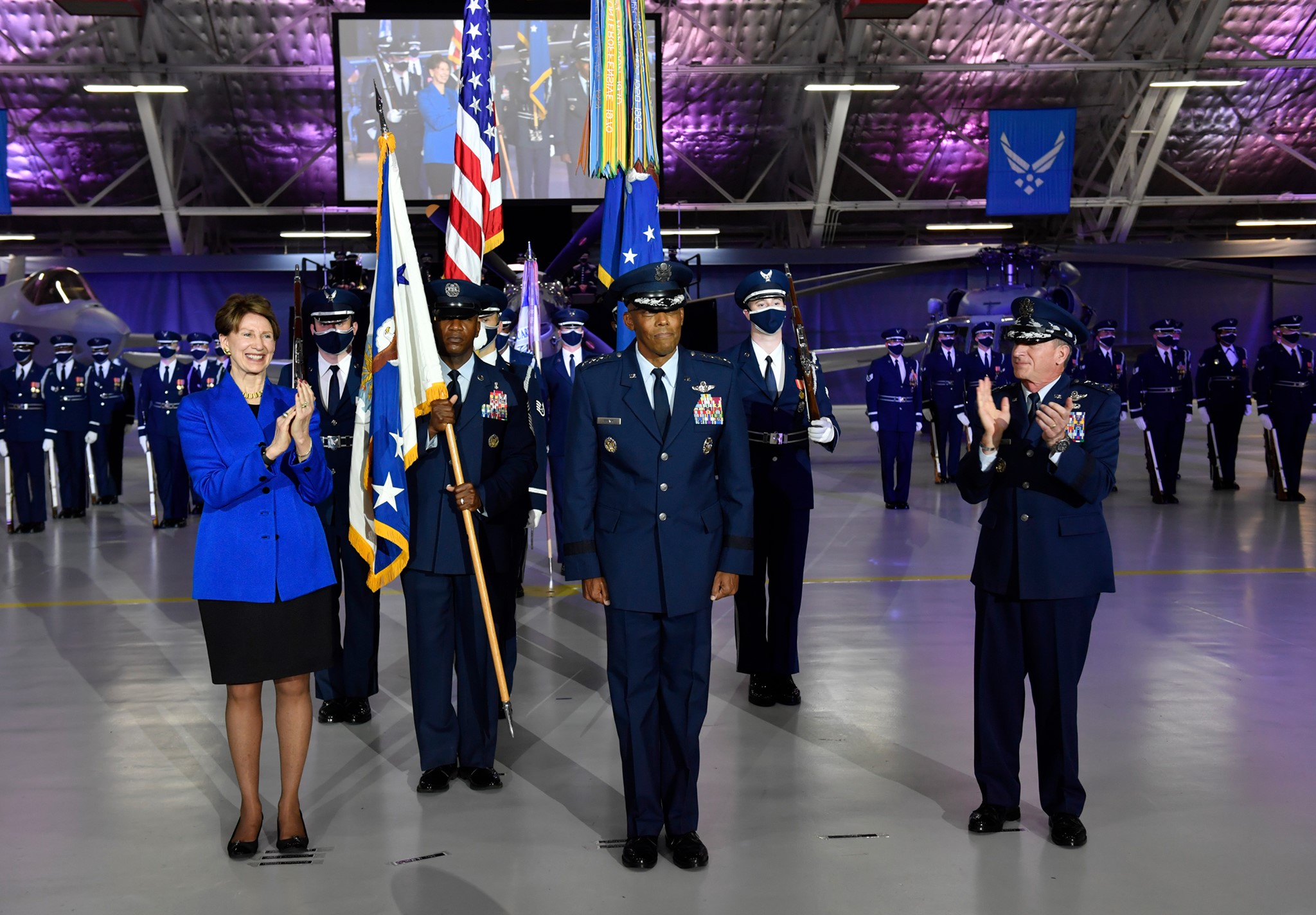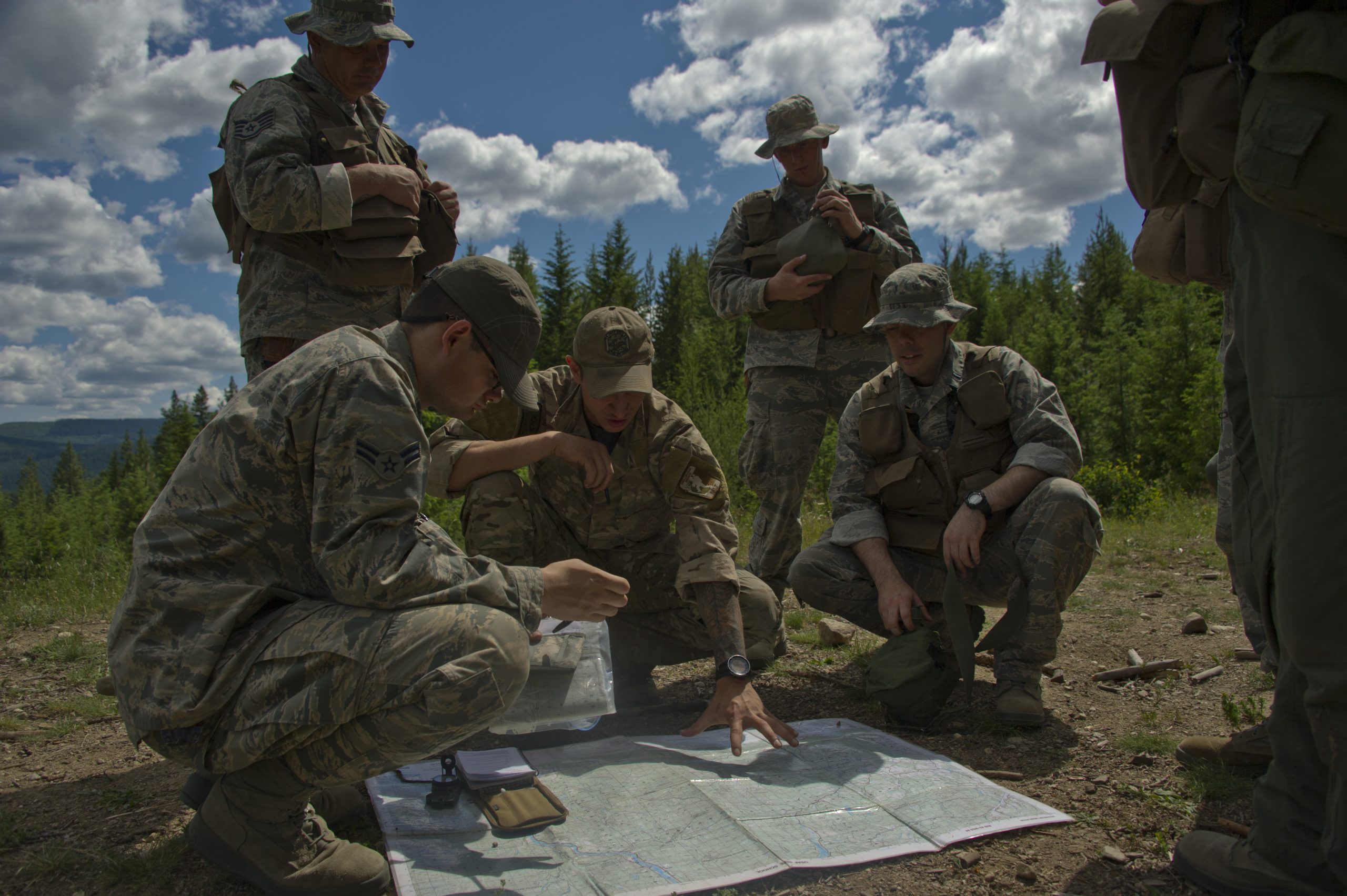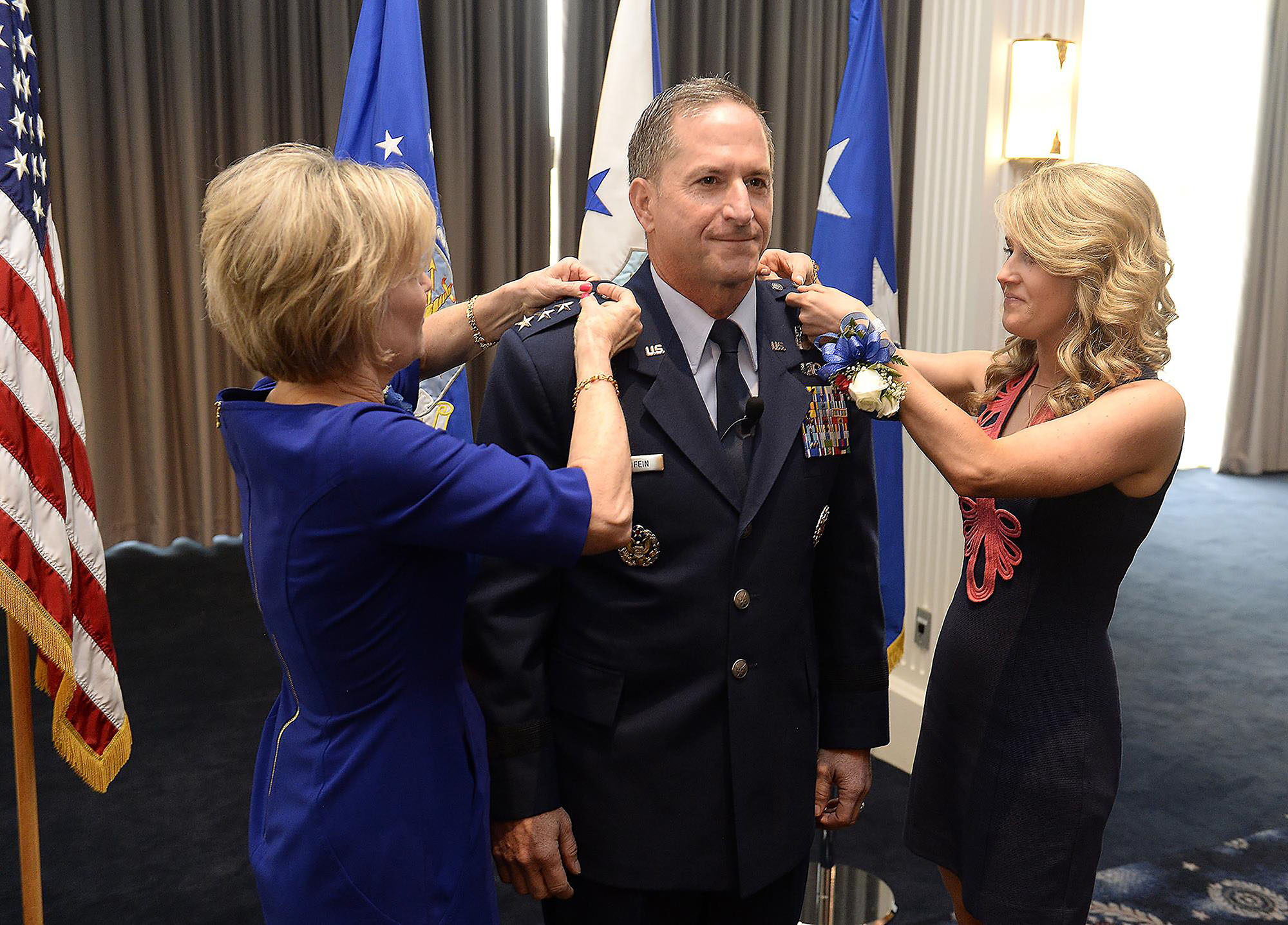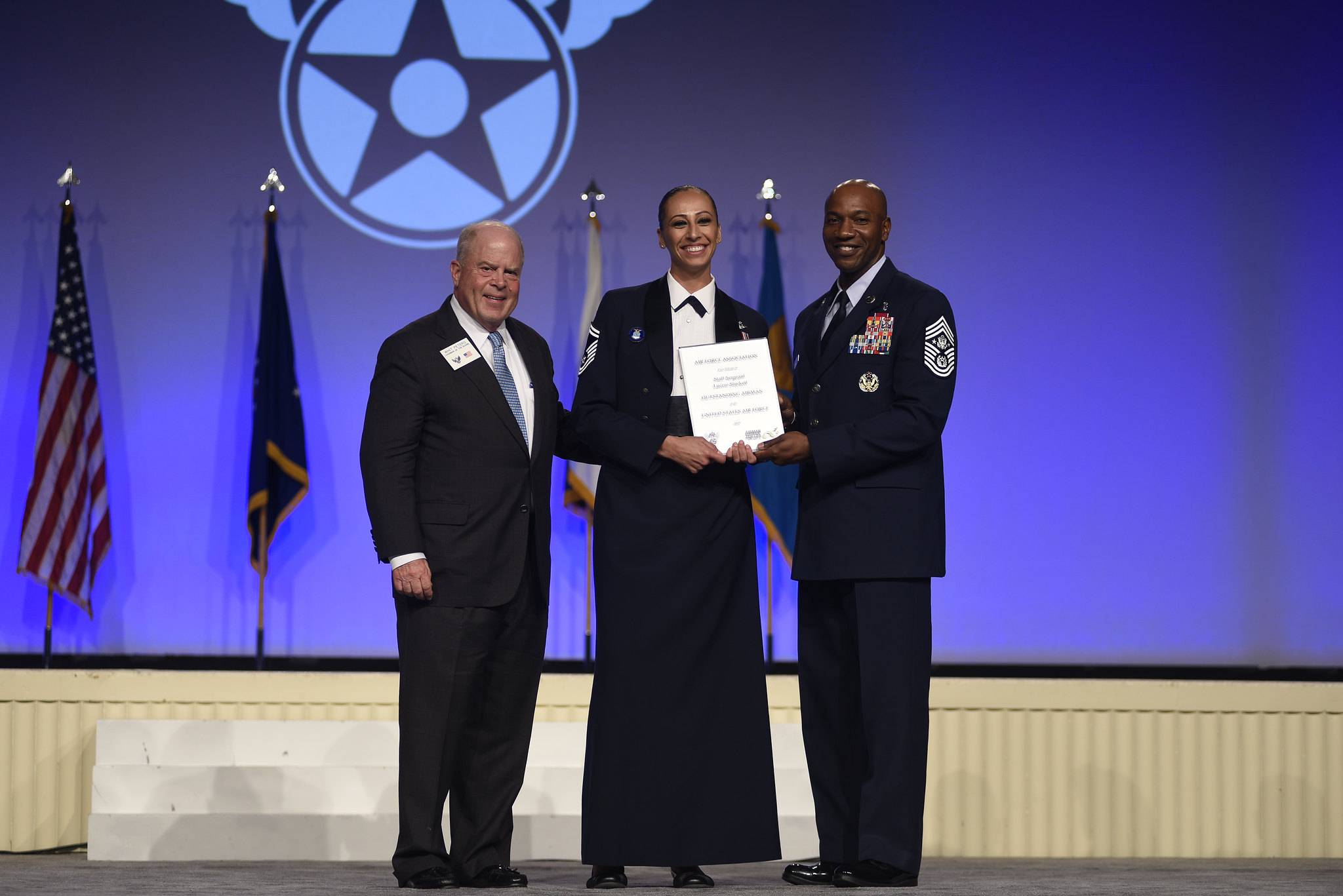Gen. Charles Q. Brown Jr. officially took the reins as Chief of Staff of the Air Force in an Aug. 6 ceremony marking the transition of leadership from retiring Gen. David L. Goldfein.
Against a backdrop of modern jets and a World War II-era P-51 in a hangar at Joint Base Andrews, Md., Brown pledged to build on Goldfein’s top three priorities: Empowering squadrons, building the Air Force’s place in the joint force, and developing joint all-domain command and control.
He will oversee nearly 700,000 Airmen and work alongside Chief of Space Operations Gen. John W. “Jay” Raymond as the Space Force stands up within the Department of the Air Force.
“We must no longer defer, but must accelerate the needed change and tough choices we’ve often discussed,” while empowering Airmen and improving their quality of life, Brown said. Those challenges, from addressing racism to building the future aircraft fleet, will be “difficult, but not impossible” to meet.
He has also raised the idea that it’s time to rethink how the military splits up its roles and missions, which could lead to notable changes during his tenure.
Brown, the first African American officer to lead a U.S. military service, thanked his family and the Black Air Force leaders who preceded him, such as the Tuskegee Airmen; Gen. Daniel James Jr., special assistant to the Air Force chief of staff in the 1970s; and Edward J. Dwight, the first Black man who trained as an astronaut. While retired Army Gen. Colin Powell was chairman of the Joint Chiefs of Staff, he never led a military service.
“I’m in awe that I’m even standing here as the 22nd Air Force Chief of Staff, considering I’d only planned to stay in the Air Force four years, and I almost quit ROTC after the first semester,” Brown said.
“You can expect my leadership to be framed by the same four tenets I’ve used throughout my career: execute at a high standard, be disciplined in execution, pay attention to details, and have fun,” he added.
He returns to the Pentagon from Pacific Air Forces, where he managed resources for air combat operations in the vast Indo-Pacific. Maintaining a strong U.S. presence in the region is a top priority of the current National Defense Strategy.
Defense Secretary Mark T. Esper recounted Brown’s long string of combat assignments in key hot spots around the world—the Middle East, Africa, and the Indo-Pacific—as well as his time running the Air Force Weapons School. The new chief “masterfully orchestrated and led the air war against the Islamic State,” and is “humble, approachable, and credible,” Esper said.
Esper and Army Gen. Mark A. Milley, chairman of the Joint Chiefs of Staff, praised Brown as a leader who has made the military a more ready, stronger partner in combat theaters around the world.
“In C.Q., we have all that is good about America,” Milley said. The leadership change is “really about an idea that’s worth defending. … Under the stars and stripes, we are all Americans.”
Meanwhile, Goldfein will retire to San Antonio, Texas, after nearly 40 years in the military and four as CSAF.
Air Force Secretary Barbara M. Barrett paid tribute to Goldfein’s exceptional career as an Airman, recounting the heroics that led to his two Distinguished Flying Crosses. After being shot down, evading capture, and getting rescued in the Balkans in 1999, Goldfein flew a mission “the very next night,” Barrett said. Among the aircraft in the hangar were an F-16 like Goldfein’s, and an HH-60G Pave Hawk rescue helicopter to commemorate those who rescued him.
“Dave Goldfein is an extraordinary warrior,” Barrett said. She noted many individual stories of his help and encouragement to Airmen, and his persistence in obtaining a posthumous Medal of Honor for MSgt. John Chapman.
“He has said that what is best for the joint force is best for the Air Force,” Barrett observed. “Among his legacies are squadron revitalization; force modernization; the B-21 Raider, data management digitization; monumental groundwork behind the Space Force, and the ever-present JADC2,” which Goldfein championed among the Joint Chiefs of Staff.
Barrett did not mention the selection of the T-7A Red Hawk trainer jet as another modernization milestone on Goldfein’s watch, but one of the first examples of the plane was in the hangar alongside an F-35A Joint Strike Fighter.
Milley paid tribute to Goldfein’s character, saying he “never backs down from truth to power” and stays cool under pressure. Goldfein is the “most professional officer” he has ever encountered, Milley said.
Esper also thanked Goldfein and his family for their “unfailing devotion” to the nation over his 37-year career.
Goldfein led “the most advanced, the most capable, and the most lethal Air Force in the world and in history,” Esper said, “pushing a budget of nearly $700 billion” over five years to support global combat operations and advance personnel and research initiatives.
Goldfein was the right officer to shift the focus of the Air Force to great power competition when the new National Defense Strategy rolled out in 2018, Esper said, and the service is stronger because of his leadership.
Goldfein thanked his wife Dawn, his family, mentors, and all Air Force members and civilians, calling the running of the service “the ultimate team contact sport.” He urged the Air Force to stay ahead of change, quoting Italian airpower visionary Giulio Douhet as saying, “Victory smiles upon those who anticipate the change in the character of war, not upon those who wait to adapt themselves after the changes occur.”
Brown is a true warrior, leader, and friend, Goldfein said: “The future of the Air Force has never been brighter.”

The ceremony was followed by A-10, F-16, F-22, and P-51 flyovers as well as a performance by the Thunderbirds aerial demonstration team. The flight line also featured a B-52 and B-2 stealth bomber on static display, along with C-17 and KC-135 tanker aircraft.
Editor’s Note: This story was updated on Aug. 6 at 5:11 p.m. EDT to include ceremony video.












